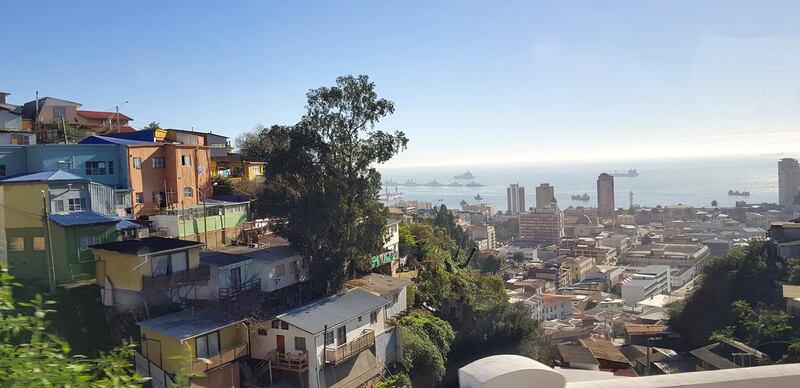Once I finally set foot in Santiago, after a 21-hour flight with a brief stop in Sao Paulo, it’s late on a winter’s night in July and pouring with rain. But the peach sunrise I’m greeted with the next morning offers the promise of something more, and the beauty of the Chilean capital’s dawns and dusks is unparalleled.
With its skyscrapers and busy streets, the city would look like any other if not for the backdrop of the jagged snow-frosted Andes beneath the pink sky.
On my first chilly morning, Santiaguinos walk briskly to work in heavy jackets, their hands stuffed in their pockets. Nature is entwined in the city: the Mapocho River weaves between concrete buildings, and large plots of land are reserved as public parks. Despite the season, most trees still carry their leaves and, confusingly, thick-trunked palm trees – the endemic Chilean palm – still flourish despite lows of 2°C. Banana trees planted outside peoples’ homes have wilted and bike lanes go unused.
Santiago is Chile’s most populous city, with 5.2 million people, and is where generations of immigrants have called home – a source of pride for many.
The capital is worth a pit stop, but what this country has to offer becomes unique if you venture a little beyond it. Two hours east of the capital, at the edge of the world, is Valparaiso: a bohemian-looking university city that creeps up the mountains from the ocean. Houses in every colour are stacked haphazardly along the coast and up the hills. From a height, it looks as though a higher power has tipped out a box of giant mixed Lego and left the pieces where they fell.
A peek down any cobblestoned street is an adventure for the eyes: graffiti, sprayed in kaleidoscopic colours, adorns every wall. Every door, side-street, nook and cranny is a work of art.
“The higher up the mountain you go, the more dangerous it is,” says my tour guide, as our driver weaves through increasingly narrow streets ever higher up the slope. La Sebastiana, the house of famed poet Pablo Neruda, sits farther up the hills.
We stop at what the guide says is the last street before the area gets rough. Cats bathe in the sun, oblivious to one of the best views that Valparaiso has to offer: the coastline.
______________
Read more:
[ Executive travel: Emirates eases the rigour of taking a 21-hour flight to Santiago, Chile ]
[ Chilean Palestinian football club blurs line between sports and politics ]
[ Savour the sights and tastes of Santiago ]
______________
Some of Chile’s finest food can also be sampled in this town. I am enticed by the smell of empanadas (pastries stuffed with meaty fillings, folded into half-moons and baked golden) wafting through the streets, and sopaipillas (pancakes made with pumpkin puree, fried into discs and boiled in dark, sticky molasses).
About 30 minutes north along the coast is Vina del Mar, Chile’s answer to Miami. In the summer, it’s a surfers’ paradise, but in winter, those same waves get so high that they intrude on the main road, sometimes causing it to be closed.
Along the seafront, a busker in a straw cowboy hat and worn-out shoes sings Chilean folk songs, as couples walk hand-in-hand, dodging sea spray that speckles the faces of passers-by. Stalls sell ice cream as if it’s not winter and, all the while, Valparaiso glitters in the background as the sun begins to set and street lights flicker on.
The next morning, I am up before the sun has risen to board an hour-and-a-half Latam Airlines flight to Puerto Montt, before a drive to Puerto Varas. The latter is a southern port city on the edge of Patagonia. Here, nature sprawls and an oddity has flourished: German culture.
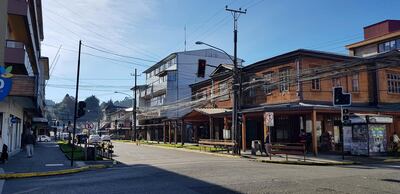
Prussian immigrants settled at the foot of Lake Llanquihue, the second-largest in the country, in 1852, building distinctly European homes using the abundance of cedar wood to pave delicate shingle.
Small signs point to the town’s ancestry. Chief among these clues are the dessert shops displaying kuchen – fruit-filled pastries and colourful cakes topped high with cream. Long queues form outside these shops as customers emerge balancing large parcels in their arms, with wide grins on their faces.
It is on this part of my journey that I discover the real beauty of Chile: thundering waterfalls, thick forests and glassy lakes with active volcanoes mirrored in them. In the summer, people can swim in the lake, then drive 45 minutes towards the mountains to play in the snow.
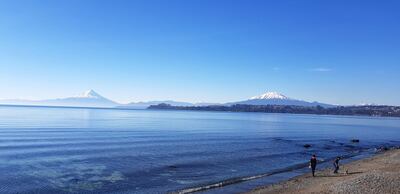
It is also in Puerto Varas that I meet Guillermo Winkler, 55, my tour guide who succinctly sums up all there is to love about Chilean life. “It never gets boring; the four seasons are perfectly well marked and totally different,” he says.
Winkler, a lanky, fair man with whitening hair and a warm smile, has happily given the same tour twice a week for 29 years.
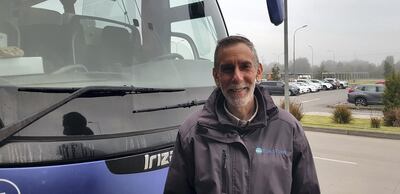
He tells me that he celebrates payday each month by buying a whole cake and inviting friends over. “If nobody comes, I will not complain, I will eat the whole thing,” he says.
He is like many of the Chileans I meet: proud of their country. And looking around, it’s not difficult to see why.
On a bus east, towards the bordering farmland of Peulla, I make a stop at the Petrohue Waterfalls. Turquoise lake-water gushes through rocks made from cooled lava that once spewed from the Osorno Volcano – a site that Chileans will fiercely defend as not looking like Mount Fuji; rather, the Japanese mountain imitated their snow-topped giant.
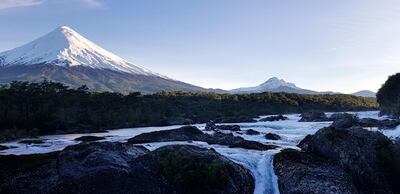
In Peulla, I hop on an exposed safari car that takes me to an alpaca farm. It’s hard to contain my excitement from my first encounter with a curious alpaca, which slobbers on my hands as I pet it. Here, vast expanses of land stretch out, seemingly untouched by mankind, apart from the occasional farm or cowboy riding a horse.
On my final day in the southern city, I bid Winkler farewell and present him with a piece of his favourite cake that I purchased in town. He explains that beyond his love for desserts, his ritual is “more about taking a moment to enjoy life and be grateful”.
There is much to be grateful for here. From the driest desert in the world, the Atacama, in the north, to the ancient glaciers in the south, nature’s marvels are on full display in this sliver of a country.
Leaving Chile, I know I would take that long flight again to explore the rest of the country – heck, having flown in business, I would even do it sat upright in economy, battling for elbow space and watching a movie that has been “adjusted for a smaller screen”.
